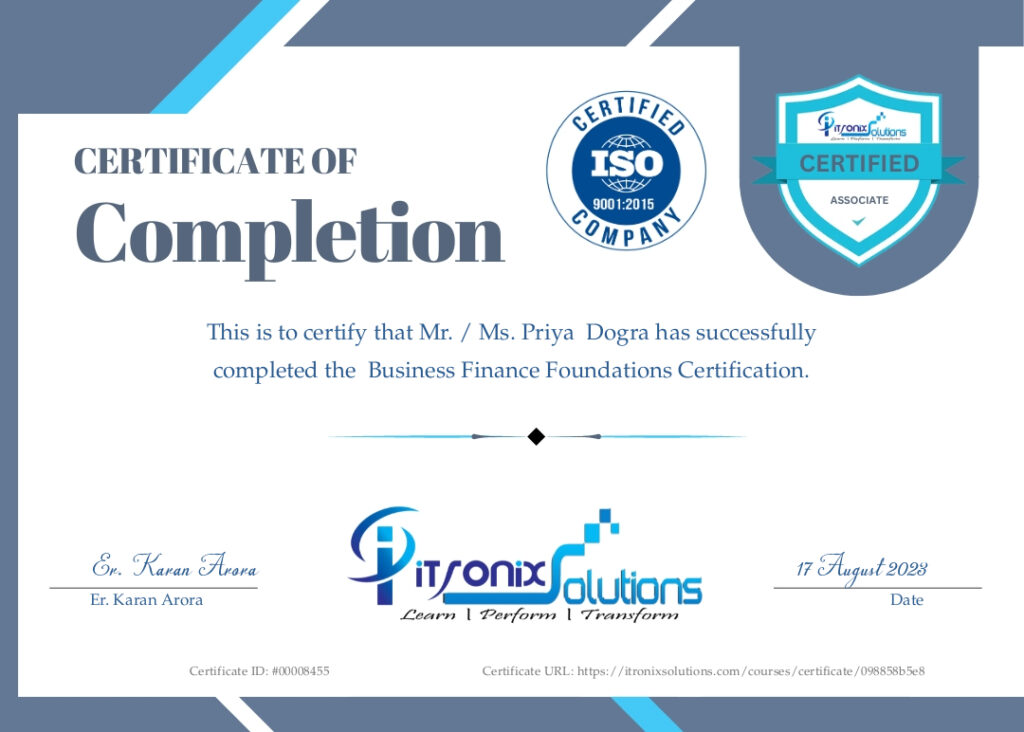Enroll Here: Business Finance Foundations FREE Certification
Business finance refers to the management of money, funds, and other financial resources within an organization to achieve its financial objectives and support its operations, growth, and strategic goals. It encompasses various financial activities and decisions made by businesses to ensure effective allocation and utilization of resources. Business finance covers a wide range of areas, including:

- Financial Planning: Creating a comprehensive plan that outlines the company’s financial goals, strategies, and actions to achieve those goals. It involves budgeting, forecasting, and setting financial targets.
- Capital Budgeting: Evaluating and selecting investment opportunities, such as new projects, acquisitions, or expansions, by assessing their potential returns and risks.
- Capital Structure Management: Determining the optimal mix of equity and debt financing that minimizes the cost of capital while balancing financial risk.
- Working Capital Management: Managing the company’s short-term assets and liabilities to ensure smooth day-to-day operations. This involves maintaining the right level of inventory, managing accounts receivable and accounts payable, and optimizing cash flow.
- Risk Management: Identifying and mitigating financial risks, such as interest rate risk, currency risk, and market volatility, through strategies like hedging and insurance.
- Financial Analysis: Analyzing financial statements, ratios, and performance indicators to assess the company’s financial health, profitability, liquidity, and overall performance.
- Funding and Financing: Obtaining funds through various sources, including equity investments, loans, bonds, and other financing options.
- Dividend Policy: Deciding on the distribution of profits to shareholders in the form of dividends versus retaining earnings for reinvestment.
- Mergers and Acquisitions: Evaluating and executing mergers, acquisitions, and divestitures to enhance growth and value for the company.
- International Finance: Dealing with financial transactions and risks associated with conducting business across different countries and currencies.
- Financial Reporting: Preparing accurate and timely financial statements in compliance with accounting standards and regulations.
- Corporate Governance and Ethics: Ensuring transparent financial practices, ethical behavior, and effective corporate governance to build trust with stakeholders.
Business finance is a critical aspect of organizational management, as it provides the necessary resources for day-to-day operations, expansion, innovation, and strategic initiatives. Effective management of business finance contributes to a company’s long-term sustainability and success in the competitive marketplace.
Business Finance Foundation Certification EXAM Answers
Question 1: What does ROI stand for in business finance?
- Return on Investment
- Rate of Income
- Risk of Inflation
- Revenue Over Interest
Question 2: What is the primary goal of financial management?
- Maximizing sales revenue
- Minimizing costs
- Maximizing shareholder wealth
- Maximizing employee satisfaction
Question 3: Which financial statement provides a snapshot of a company’s financial position at a specific point in time?
- Income statement
- Cash flow statement
- Balance sheet
- Statement of retained earnings
Question 4: The cost of borrowing money, expressed as a percentage, is known as:
- Interest rate
- Inflation rate
- Capital gain
- Dividend yield
Question 5: What does the term “liquidity” refer to in finance?
- Profitability of a company
- Ability to meet short-term obligations
- Ability to generate long-term investments
- Ability to acquire assets at low cost
Question 6: What is the purpose of the cash flow statement?
- To show the company’s net income
- To provide a summary of the company’s assets and liabilities
- To display changes in equity over time
- To track the movement of cash in and out of a company
Question 7: What does the term “diversification” mean in investment?
- Concentrating investments in a single asset
- Spreading investments across different assets
- Focusing only on short-term investments
- Investing in high-risk, high-reward assets
Question 8: Which financial ratio measures a company’s ability to cover its short-term obligations with its most liquid assets?
- Debt-to-Equity ratio
- Gross Profit Margin
- Current Ratio
- Return on Assets
Question 9: The process of estimating the future financial performance of a company is called:
- Financial analysis
- Budgeting
- Forecasting
- Auditing
Question 10: What is the difference between “equity” and “debt” in a company’s capital structure?
- Equity refers to long-term borrowing, while debt represents ownership stakes.
- Equity represents ownership stakes, while debt refers to short-term borrowing.
- Equity represents short-term borrowing, while debt refers to long-term ownership stakes.
- Equity and debt are synonymous terms representing different types of assets.
 Priya Dogra – Certification | Jobs | Internships
Priya Dogra – Certification | Jobs | Internships



